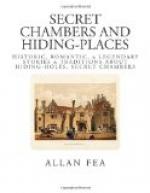A secret chamber was discovered at the back of a fireplace in an old house at Deal, from which a long underground passage extended to the beach. The house was used as a school, and the unearthly noises caused by the wind blowing up this smugglers’ passage created much consternation among the young lady pupils. A lady of our acquaintance remembers, when a schoolgirl at Rochester, exploring part of a vaulted tunnel running in the direction of the castle from Eastgate House, which in those days was a school, and had not yet received the distinction of being the “Nun’s House” of Edwin Drood. Some way along, the passage was blocked by the skeleton of a donkey! Our informant is not given to romancing, therefore we must accept the story in good faith.
All round the coast-line of Kent once famous smuggling buildings are still pointed out. Movable hollow beams have been found supporting cottage ceilings, containing all kinds of contraband goods. In one case, so goes the story, a customs house officer in walking through a room knocked his head, and the tell-tale hollow sound (from the beam, not from his head, we will presume) brought a discovery. At Folkestone, tradition says, a long row of houses used for the purpose had the cellars connected one with the other right the way along, so that the revenue officers could be easily evaded in the case of pursuit.
The modern utility of a convenient secret panel or trap-door occasionally is apparent from the police-court reports. The tenements in noted thieves’ quarters are often found to have intercommunication; a masked door will lead from one house to the other, and trap-doors will enable a thief to vanish from the most keen-sighted detective, and nimbly thread his way over the roofs of the neighbouring houses. There was a case in the papers not long since; a man, being closely chased, was on the point of being seized, when, to the astonishment of his pursuers, he suddenly disappeared at a spot where apparently he had been closely hemmed in.
Many old houses in Clerkenwell were, sixty or seventy years ago, notorious thieves’ dens, and were noted for their hiding-places, trap-doors, etc., for evading the vigilance of the law. The name of Jack Sheppard, as may be supposed, had connection with the majority. One of these old buildings had been used in former years as a secret Jesuits’ college, and the walls were threaded with masked passages and places of concealment; and when the old “Red Lion Inn” in West Street was pulled down in 1836, some artful traps and false floors were discovered which tarried well with its reputation as a place of rendezvous and safety for outlaws. The “Rising Sun” in Holywell Street is a curious example, there being many false doors and traps in various parts of the house; also in the before-mentioned Newton Street a panel could be raised by a pulley, through which a fugitive or outlaw could effect his escape on to the roof, and thence into the adjoining house.




